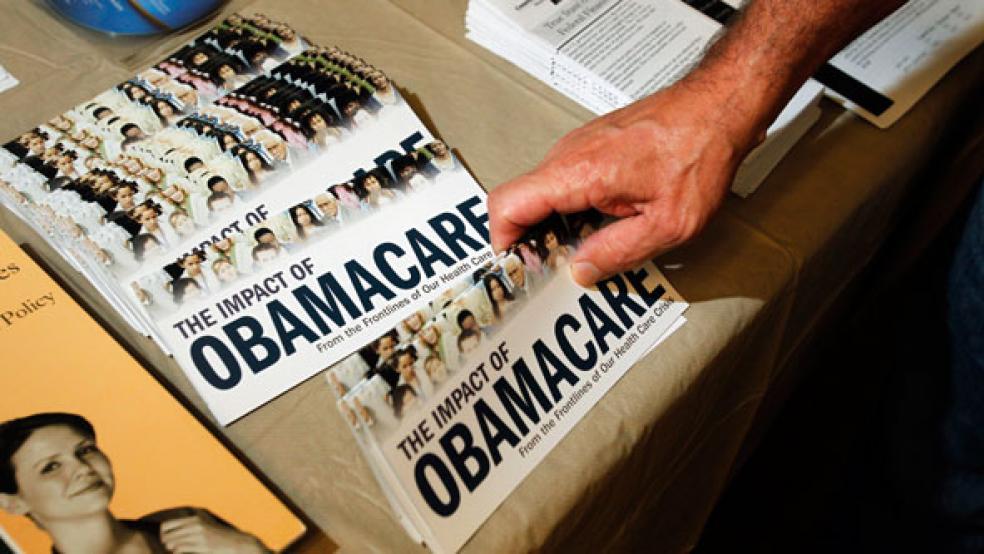The countdown to Obamacare implementation is on. And owners of businesses with 50 or more employees have begun making some tough decisions on ways to minimize their long-term costs.

That’s because under the law, businesses with at least 50 “full-time equivalent” employees have to provide health care to their workers or pay a penalty. Recent surveys indicate that many small-and medium-sized businesses are restricting hiring and cutting hours to get under that threshold. And according to Kenneth Laks, a certified public accountant at AVZ & Company, many businesses simply aren’t prepared.
“I’m seeing a lot of people not paying attention, and even after warning them they’re still not paying attention,” Laks told The Fiscal Times last week. “A lot of people are not aware of the simplest thing.”
The 2010 Affordable Care, designed to extend health care insurance to millions of uninsured Americans, penalizes firms employing 50 or more people that don’t offer health insurance – or that offer coverage below minimum standards. Regardless of whether companies abide by the new rules or seek a way around them, the stakes are high.
According to the Obama administration, 96 percent of all firms in the United States or 5.8 million out of 6 million total firms have fewer than 50 full time employees and therefore are exempt from the Affordable Care Act. These 5.8 million firms employ nearly 34 million workers. Moreover. more than 96 percent of firms with 50 or more employees already offer health insurance to their workers. Less than 0.2 percent of all firms -- or about 10,000 out of 6 million-- may face employer responsibility requirements. The administration contends that many firms that do not currently offer coverage will be more likely to do so because of lower premiums and wider choices in the exchanges.
The new law takes full effect Oct. 1, when the federal government and state officials launch new on-line insurance exchanges in all 50 states and the District of Columbia where uninsured Americans can apply for affordable or government-subsidized policies.
For many companies, the decision to provide new coverage and fully abide by the law could cost them hundreds of thousands or even millions of dollars. Others that choose not to offer insurance could be hit with substantial federal penalties - although in some cases it would be far less expensive for them to pay the penalties than provide the insurance.
Now small and medium-sized businesses are being forced to make a decision that has both moral and fiscal aspects.
From a moral standpoint, companies must decide if it’s right to provide health care to employees. It’s cheaper to pay the penalty, but is it good business? Is it the right thing to do? According to Denis Collins, an American business ethicist and professor of business at Edgewood College in Madison, Wisconsin, the answer is no.
“It’s understandable why a company would do that – it’ understandable to want to minimize your costs. So in the short term, it’s understandable. In the long term, that’s bad business,” he said. "In terms of ethics, that’s egoism. You do what’s in your self-interests. And [businesses] have the legal right to do that. But in the long term…it’s not for the greater good of their employees and it’s not for the greater good of the company, because it’s going to damage morale,” Collins continued.
Kenneth Laks sees it differently: “There are a lot of companies who are saying, ‘who cares? If we have 80 people and we don’t offer insurance, it’s heck of a lot cheaper than providing insurance.’”
The advent of the Affordable Care Act has spawned a surge in business for lawyers, CPAs and industry consultants on ways for businesses to navigate the new law and minimize their financial exposure.
A handful of experts interviewed by The Fiscal Times outlined a half-dozen tactics for dodging health care reform, including the pros and cons. They are:
1. PULL UP YOUR SOCKS AND PROVIDE HEALTH CARE INSURANCE
Pros: It will make current employees happy, while attracting new ones. As numerous studies have shown, happy workers are more productive.
Cons: It’s expensive. According to the Society for Human Resource Management, the average health care cost per employee this year was $10,522, compared to $10,034 the previous year. That number is expected to rise to $11,188 next year.
2. CUT HOURS FOR WORKERS
Pros: Cutting the hours of workers below 30 hours per week to get under the 50 worker threshold would free the employer from having to provide health care, while also avoiding the federal penalty.
Cons: Technically, it’s illegal. Under Obamacare, employers can’t just cut hours or jobs to avoid providing health care or paying the penalty; there has to be a business reason for the staff reductions. “Benefit plan attorneys are waiting for that to occur so they can bring lawsuits,” said Laks.
3. CUT JOBS
Pros: Firing employees to get under the 50-worker threshold would also free the employer from Obamacare obligations.
Cons: As in the case with cutting hours, it’s illegal. But according to Howard Rosen, an accountant at Conner Ash in St. Louis, employers are preparing to do it anyway.
“People are cutting hours and jobs now because of the 50 full-time equivalent count. They’re cutting down to 27 to 29 hours per week so they don’t have to pay,” he said. When asked if any of his clients were concerned about litigation, he replied, “None that we’ve talked with. Maybe it’s because we’re in the Midwest and we’re not as litigious or as aggressive. That has not come up and we had multiple discussions about this.”
4. PAY THE PENALTY
Pros: It’s cheaper than paying for health care. In the worst case, the penalty is just $2,000 per employee, and the first 30 don’t count. This means a company with 50 or more workers would pay an additional $40,000 in taxes each year.
Compare that to what it would cost to provide health care. Using the Society for Human Resource Management’s numbers, insuring all 50 workers would cost the company $526,100. So paying the $40,000 penalty saves the company $486,100.
Cons: Workers aren’t likely to be too happy about this decision, and it would be hard to recruit new ones.
5. OFFER BAD INSURANCE
Pros: Under Obamacare, employers can provide what’s termed “minimal essential coverage,” a fancy name for a health plan that’s so bad it doesn’t meet Obamacare requirements. The employee has the option to turn down this plan and buy insurance from an exchange. If this happens, the employer is penalized $3,000 for each worker that purchased insurance on his or her own.
The upside for employers is that this penalty is still cheaper than paying for health insurance. As mentioned in the previous example, providing insurance for a workforce of 50 would cost $526,100. Paying the penalties for pushing these workers to an exchange would only cost a maximum of $150,000, although it’s highly unlikely that every employee would chose to buy from an exchange. But even paying the maximum penalty would save the company $376,100.
Cons: Workers probably aren’t going to appreciate the offer of a bad health care plan, especially one that puts them through the trouble of purchasing insurance at an exchange.
6. DOWNGRADE "CADILLAC PLANS"
Pros: Those with high-end health care plans – known as Cadillac plans – are going to experience big changes to the way the get medical care. For many, large deductibles and cheap visits to the doctor’s office will become a thing of the past.
That’s because of Obamacare’s tax on expensive plans. Here’s how it works: for plans that cost more than $10,200 for an individual or $27,500 for a family, the employer will have to pay a 40 percent tax on the cost of the program above those levels.
Take the cost of the average plan: $10,522. Employers will be forced to pay a 40 percent tax on $322, or about $129. That might seem like a small number, but for an employer with 10,000 employees, it adds up quickly. Such a company would be paying an additional $12.9 million each year.
The tax doesn't take effect until 2018, but employers are already rolling back heath care plans to get below the threshold. If they're able to get the cost of their policies below $10,200 each, it will save them a lot of money down the line.
Cons: The obvious losers in this scenario are those workers who are having their health care downgraded.
7. HIRE A PROFESSIONAL EMPLOYER ORGANIZATION
Pros: Many small businesses are outsourcing human resources, employee benefit and payroll work to companies known as professional employer organizations (PEO). These companies exist simply to provide companies with additional employees – but strictly on a contract basis that doesn’t impact the size of their overall full-time workforce.
Workers hired under this system operate much like federal government contract workers: they are recruited by an outside firm and are paid by them, but they report to and work for another company.
Here’s how it works. Let’s create a fictional biotech firm: we’ll call it TFT Biotech, a small Silicon Valley shop with fewer than 50 workers. TFT Biotech identifies a potential employee, a hotshot Stanford grad with a degree in organic chemistry. They bring her in for an interview and decide they want her. They would then go to a PEO – says Ambrose, one of the biggest in the country – and retain them to hire her. She’ll work at TFT Biotech, but technically Ambrose will employ her.
This saves TFT Biotech money in a number of ways. It removes human resource and payroll cost. It also removes health care cost. If TFT Biotech were to hire the young woman directly, it might breach the firm’s 50-full time worker threshold, forcing it to choose between paying the penalty and providing health insurance.
Ambrose removes that burden. It provides health insurance to the young Stanford grad, as well as to thousands of other workers in the biotech, financial services and professional services industry. This large work force also gives them leverage in negotiations with insurance companies, keeping health care costs down.
Cons: There actually is little downside to this strategy for small companies. The most challenging part of working with a PEO would be managing the relationship between the employee and Ambrose. A small business going this route is counting on Ambrose to keep the employee happy with regard to health care, pay and other human resources considerations.






